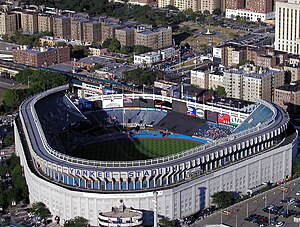 Original Yankee Stadium in August 2002 | |
 | |
| Address | East 161st Street & River Avenue |
|---|---|
| Location | The Bronx, New York City, New York, U.S. |
| Coordinates | 40°49′37″N 73°55′41″W / 40.82694°N 73.92806°W |
| Owner | City of New York |
| Operator | New York Yankees |
| Capacity | 58,000 (1923) • 82,000 (1927) • 62,000 (1929) • 71,699 (1937) • 70,000 (1942) • 67,000 (1948) • 67,205 (1958) • 67,337 (1961) • 67,000 (1965) • 65,010 (1971) • 54,028 (1976) • 57,145 (1977) • 57,545 (1980) • 57,478 (2003) • 56,936 (2005) |
| Record attendance | 123,707 on August 3, 1958 Jehovah's Witnesses International Convention[1] |
| Field size | Left Field – 318 feet (97 m) Left-Center – 399 feet (122 m) Center Field – 408 feet (124 m) Right-Center – 385 feet (117 m) Right Field – 314 feet (96 m) Backstop – 84 feet (26 m)  |
| Surface | Grass |
| Construction | |
| Broke ground | May 5, 1922 |
| Opened | April 18, 1923 April 15, 1976 (re-opening) |
| Renovated | October 1973 – April 1976 |
| Closed | September 30, 1973 (renovations) September 21, 2008 (final game) November 9, 2008 (final tour) |
| Reopened | April 15, 1976 |
| Demolished | March 16, 2009 – May 13, 2010 |
| Construction cost | $2.4 million ($34,417,738.10 in 2022) Renovations: $167 million (1976; $894 million in 2023[2]) |
| Architect | Osborn Engineering Corporation (1923) Praeger-Kavanaugh-Waterbury (1976) |
| General contractor | White Construction Co. (1923) |
| Tenants | |
| New York Yankees (MLB) 1923–1973, 1976-2008 NYU Violets (NCAA) part-time, 1926–1948 New York Yankees (AFL I / NFL) 1926–1928 New York Yankees (AFL II) 1936–1937 New York Yankees (AFL III) 1940 New York Americans (AFL III) 1941 New York Yankees (AAFC) 1946–1949 New York Yanks (NFL) 1950–1951 New York Giants (NFL) 1956–1973 Gotham Bowl (NCAA) 1962 New York Skyliners (USA) 1967 New York Generals (NPSL / NASL) 1967–1968 New York Cosmos (NASL) 1971, 1976 New York Black Yankees (NLB) 1931, 1941–1948 New York Cubans (NLB) 1941–1946 | |
The original Yankee Stadium was located in the Bronx in New York City. It was the home of the New York Yankees from 1923 to 2008, except for 1974–1975 when it was renovated. It hosted 6,581 Yankees regular season home games during its 85-year history. It was also the home of the New York Giants National Football League (NFL) team from October 21, 1956 through September 23, 1973. The stadium's nickname is "The House That Ruth Built"[3] which is derived from Babe Ruth, the baseball superstar whose prime years coincided with the stadium's opening and the beginning of the Yankees' winning history.
The stadium was built from 1922 to 1923 for $2.4 million ($43 million in 2023 dollars). Its construction was paid for entirely by Yankees owner Jacob Ruppert, who was eager to have his own stadium after sharing the Polo Grounds with the New York Giants baseball team the previous ten years. Yankee Stadium opened for the 1923 season and was hailed at the time as a unique facility in the country. Over the course of its history, it became one of the most famous venues in the United States, hosting a variety of events and historic moments during its existence. Many of these moments were baseball-related, including World Series games, no-hitters, perfect games, and historic home runs, but the stadium also hosted boxing matches, the 1958 NFL Championship Game, college football, concerts, and three Papal Masses. Its condition deteriorated in the 1960s and 1970s, prompting its closure for renovation from October 1973 through 1975. The renovation significantly altered the appearance of the venue and reduced the distance of the outfield fences.[4]
In 2006, the Yankees began building a new $2.3 billion stadium in public parkland adjacent to the stadium, which included $1.2 billion in public subsidies.[5] The design includes a replica of the frieze along the roof that had been part of the original Yankee Stadium. Monument Park, a Hall of Fame for prominent former Yankees, was relocated to the new stadium. Yankee Stadium closed following the 2008 season and the new stadium opened in 2009, adopting the "Yankee Stadium" moniker. The original Yankee Stadium was demolished in 2010, two years after it closed, and the 8-acre (3.2 ha) site was converted into a public park called Heritage Field.[6]
- ^ "8/3/1958 JEHOVAH'S WITNESSES CONVENTION - LARGEST CROWD Old Yankee Stadium Historical Plaque, Ruppert Plaza, Bronx, New York City" (Photo). flickr. April 2013. Retrieved October 9, 2019.
- ^ 1634–1699: McCusker, J. J. (1997). How Much Is That in Real Money? A Historical Price Index for Use as a Deflator of Money Values in the Economy of the United States: Addenda et Corrigenda (PDF). American Antiquarian Society. 1700–1799: McCusker, J. J. (1992). How Much Is That in Real Money? A Historical Price Index for Use as a Deflator of Money Values in the Economy of the United States (PDF). American Antiquarian Society. 1800–present: Federal Reserve Bank of Minneapolis. "Consumer Price Index (estimate) 1800–". Retrieved February 29, 2024.
- ^ "Yankee Stadium History – New York Yankees". newyork.yankees.mlb.com. Archived from the original on June 29, 2008. Retrieved September 24, 2015.
- ^ "Call it Yankee Stadium - but just isn't same". Spokesman-Review. Spokane, Washington. Associated Press. March 7, 1976. p. D8.
- ^ Neil deMause (January 15, 2009). "PRIVATE/PUBLIC COST BREAKDOWN FOR NEW YANKEES/METS STADIUMS, BY NEIL DEMAUSE, FIELDOFSCHEMES.COM, LAST UPDATE JANUARY 2009" (PDF). Retrieved September 17, 2015.
- ^ "The Yankee Stadium Redevelopment Project". New York City Department of Parks & Recreation. Retrieved May 16, 2010.